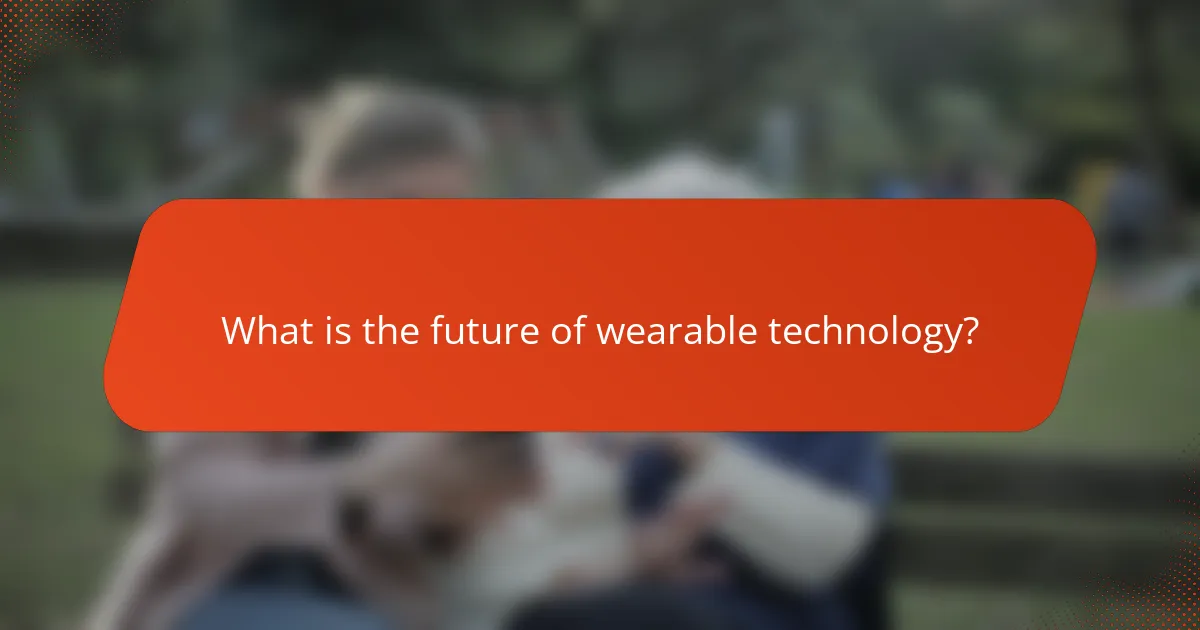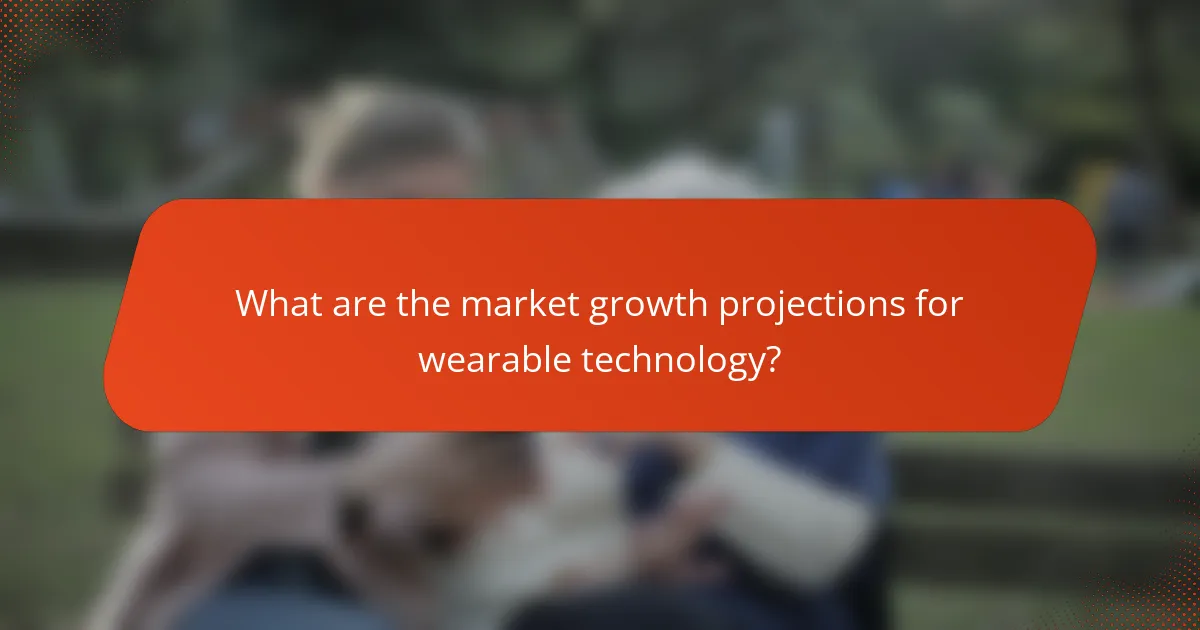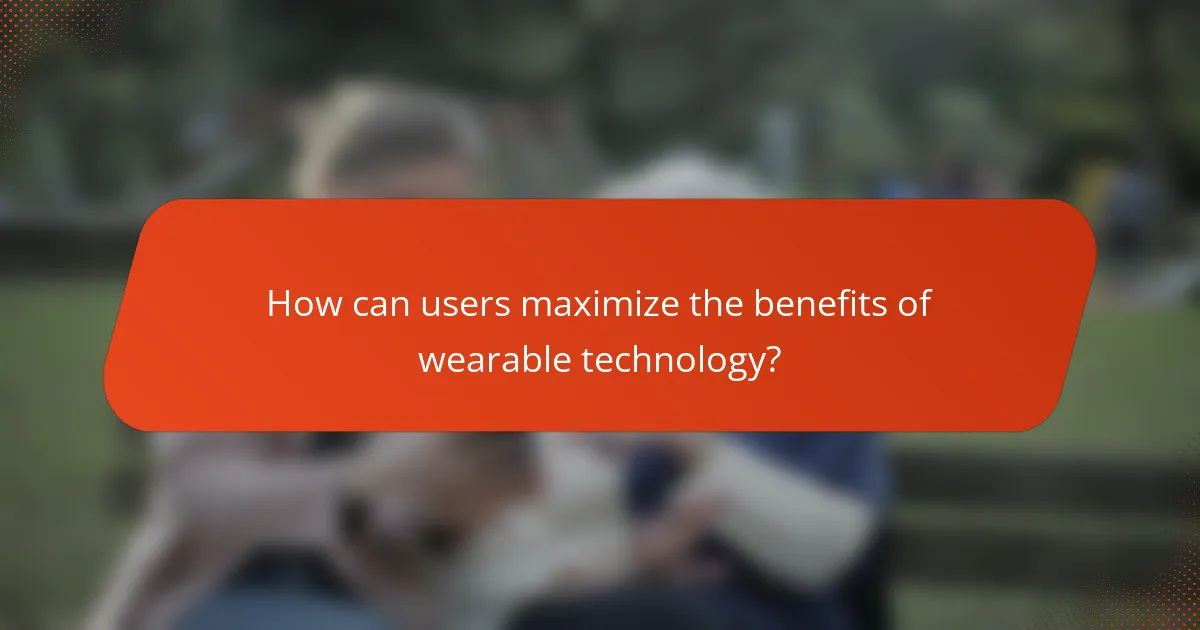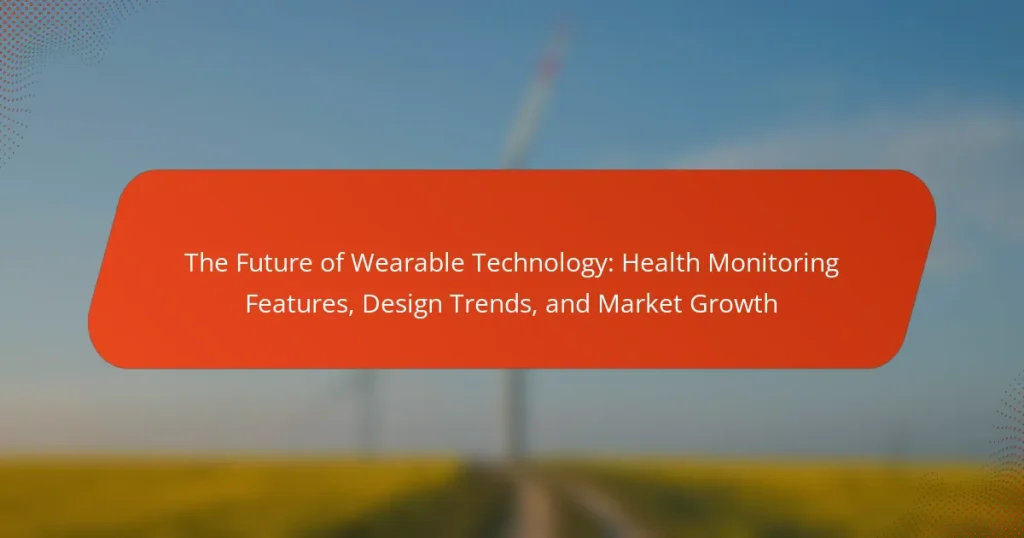Wearable technology is evolving to focus on advanced health monitoring and integration with smart environments. This article examines the projected market growth of wearable devices, anticipated to reach approximately $60 billion by 2023, driven by consumer demand for health-centric features and innovations. Key health metrics such as heart rate, glucose levels, and sleep quality will be increasingly tracked through enhanced sensors and AI, providing personalized insights. Additionally, the article highlights the growing trend of fashionable and versatile designs that seamlessly integrate into daily life, as well as the benefits of consistent user engagement with these devices to improve health outcomes.

What is the future of wearable technology?
The future of wearable technology is focused on advanced health monitoring and integration with smart environments. Devices will increasingly track health metrics like heart rate, glucose levels, and sleep quality. Enhanced sensors and AI will improve accuracy and provide personalized insights. Wearable technology will also become more fashionable and versatile, blending seamlessly into daily life. Market growth is projected to reach $60 billion by 2023, driven by consumer demand for health-focused features. Companies are investing in research and development to innovate and enhance user experiences. Integration with IoT devices will create a connected ecosystem for users. These trends indicate a significant evolution in the functionality and appeal of wearable technology.
How is wearable technology evolving in the health sector?
Wearable technology is evolving rapidly in the health sector. Innovations include advanced sensors for real-time health monitoring. Devices now track vital signs, sleep patterns, and physical activity more accurately. Integration with mobile apps enhances user engagement and data analysis. Machine learning algorithms are improving predictive health analytics. Wearable devices are increasingly used in chronic disease management. The global market for health wearables is projected to reach $60 billion by 2023. This growth reflects rising consumer demand for personalized health insights.
What are the key health monitoring features of wearable devices?
Key health monitoring features of wearable devices include heart rate monitoring, sleep tracking, activity tracking, and blood oxygen level measurement. Heart rate monitoring provides real-time data on cardiovascular health. Sleep tracking analyzes sleep patterns to improve rest quality. Activity tracking records steps, distance, and calories burned to promote physical fitness. Blood oxygen level measurement assesses respiratory health and can indicate potential issues. These features are supported by sensors that collect and analyze data continuously. Studies show that wearable devices can significantly enhance personal health management and awareness.
How do these features enhance user health management?
Health monitoring features in wearable technology enhance user health management by providing real-time data tracking. These features allow users to monitor vital signs like heart rate, blood pressure, and oxygen levels continuously. By offering personalized insights, wearables help users understand their health trends over time. This data can lead to early detection of potential health issues. Studies show that continuous monitoring can reduce hospital visits by up to 30%. Additionally, reminders for medication and activity can improve adherence to health plans. Overall, these features empower users to take proactive steps towards better health.
What design trends are emerging in wearable technology?
Emerging design trends in wearable technology include minimalistic aesthetics, customizable interfaces, and enhanced ergonomics. Minimalistic designs focus on sleek, unobtrusive forms that blend seamlessly with everyday attire. Customizable interfaces allow users to personalize their experience, adapting the display and features to individual preferences. Enhanced ergonomics prioritize user comfort, ensuring that devices fit well and are easy to wear for extended periods. Additionally, the integration of sustainable materials is becoming more prevalent, reflecting a growing consumer demand for eco-friendly products. The shift towards multifunctionality is also notable, with devices combining health monitoring, fitness tracking, and communication features into single units. These trends indicate a clear direction towards more user-centric, stylish, and functional wearable technology.
How do aesthetics influence consumer choice in wearables?
Aesthetics significantly influence consumer choice in wearables. Consumers are drawn to products that are visually appealing and align with their personal style. A study by the Journal of Fashion Marketing and Management found that design elements such as color, shape, and material impact purchasing decisions. Furthermore, 60% of consumers reported that aesthetics are a key factor in their choice of wearable technology. This indicates that brands must prioritize design to attract buyers. In a competitive market, aesthetic appeal can differentiate products and enhance brand loyalty.
What materials are being used in the latest wearable designs?
Latest wearable designs utilize materials like silicone, fabric, plastic, and metal. Silicone is favored for its flexibility and comfort. Fabric materials enhance breathability and style. Plastic is lightweight and cost-effective, making it widely used. Metal components, such as stainless steel, provide durability and a premium feel. Advanced materials like carbon fiber and graphene are emerging for their strength and lightweight properties. These choices reflect trends in user comfort, functionality, and aesthetics in wearable technology.

What are the market growth projections for wearable technology?
The market growth projections for wearable technology indicate a significant expansion. The global wearable technology market is expected to reach approximately $60 billion by 2023. This represents a compound annual growth rate (CAGR) of about 15% from 2018 to 2023. Factors driving this growth include increased health awareness and advancements in technology. The demand for fitness trackers and smartwatches contributes significantly to market expansion. Additionally, innovations in health monitoring features are attracting consumers. As a result, wearable technology is becoming more integrated into daily life.
How is consumer demand shaping the wearable technology market?
Consumer demand is significantly shaping the wearable technology market. Increased interest in health monitoring has driven innovation in features. For example, devices now frequently include heart rate sensors and fitness tracking capabilities. According to a report by Statista, the global wearable technology market is projected to reach $60 billion by 2023. This growth is fueled by consumer preferences for multifunctional devices. Additionally, the demand for stylish designs has led brands to prioritize aesthetics alongside functionality. As a result, manufacturers are collaborating with fashion designers to create appealing products. Consumer feedback is also influencing product development cycles, leading to faster iterations. Overall, consumer demand is a key factor in the evolution of wearable technology.
What demographic trends are influencing market growth?
Aging populations are a significant demographic trend influencing market growth. The global population aged 65 and older is projected to reach 1.5 billion by 2050, according to the United Nations. This increase drives demand for health monitoring wearables. Younger consumers are also embracing wearable technology for fitness and wellness tracking. Research indicates that 80% of millennials are interested in using wearables for health purposes. Rising health awareness among various age groups further stimulates market growth. Additionally, urbanization contributes to the adoption of wearable technology, as city dwellers seek convenient health solutions. These trends collectively shape the future of the wearable technology market.
How are advancements in technology impacting market expansion?
Advancements in technology are significantly driving market expansion in various sectors. Enhanced connectivity through the Internet of Things (IoT) allows devices to communicate seamlessly. This interoperability increases consumer adoption of wearable technology. Improved data analytics enables companies to understand consumer behavior better. As a result, businesses can tailor products to meet specific needs. The global wearable technology market is projected to grow at a CAGR of 23.8% from 2021 to 2028. Innovations in health monitoring features attract a broader customer base. Enhanced user experiences foster brand loyalty and repeat purchases.
What are the challenges facing the wearable technology market?
The wearable technology market faces several challenges. One significant challenge is data privacy concerns. Users are increasingly wary of how their health data is collected and used. Regulatory compliance adds complexity for manufacturers. Additionally, battery life remains a critical limitation. Many devices require frequent charging, which can deter users. Integration with existing health systems is another hurdle. Compatibility issues can hinder widespread adoption. Lastly, high costs can restrict access for consumers. These factors collectively impact market growth and user acceptance.
What regulatory issues affect wearable health devices?
Regulatory issues affecting wearable health devices include compliance with health and safety standards. These devices must adhere to regulations set by authorities like the FDA in the United States. The FDA classifies wearable health devices based on their intended use, affecting their regulatory pathway. Data privacy and security are also major concerns, as these devices collect sensitive health information. Regulations like HIPAA govern how personal health data must be handled. Additionally, manufacturers must ensure accurate claims about health monitoring capabilities to avoid misleading consumers. International regulations may vary, complicating global market entry. Compliance with these regulations is essential for market acceptance and consumer trust.
How do consumer privacy concerns impact market growth?
Consumer privacy concerns significantly impact market growth by influencing purchasing decisions. When consumers feel their data is at risk, they are less likely to adopt new technologies. A survey by Pew Research Center found that 79% of Americans are concerned about how their data is used. This concern leads to hesitance in purchasing wearable technology. Companies may face reduced sales if they do not prioritize data security. Additionally, stricter regulations on data privacy can increase compliance costs for businesses. This can hinder innovation and slow market expansion. Overall, consumer privacy concerns create barriers that can limit growth in the wearable technology sector.

How can users maximize the benefits of wearable technology?
Users can maximize the benefits of wearable technology by regularly tracking health metrics. Consistent monitoring of heart rate, sleep patterns, and activity levels enhances personal health insights. Setting specific health goals within the device can increase motivation and adherence. Utilizing reminders and alerts for physical activity can promote a more active lifestyle. Engaging with companion apps provides deeper analytics and personalized feedback. Users should also ensure their devices are updated for optimal performance and features. Research indicates that users who actively engage with their wearables experience improved health outcomes. A study published in the Journal of Medical Internet Research found that users who tracked their health data showed significant improvements in fitness levels.
What best practices should users follow when using wearable devices?
Users should regularly update the software on their wearable devices. This ensures optimal performance and security. They should also calibrate the device according to manufacturer instructions. Proper calibration enhances accuracy in health monitoring.
Wearing the device consistently is crucial for reliable data collection. Users should also charge the device regularly to prevent interruptions in monitoring. Additionally, maintaining a clean device helps ensure accurate readings. Users should follow guidelines for specific health tracking features, such as heart rate monitoring.
Engaging with the device’s companion app can provide insights into usage patterns. Users should also set realistic goals based on the data collected. These practices enhance the effectiveness of wearable devices in health monitoring.
How can users integrate wearables into their daily health routines?
Users can integrate wearables into their daily health routines by setting specific health goals. These goals may include tracking steps, monitoring heart rate, or managing sleep patterns. Wearables provide real-time data that helps users stay accountable. For instance, a fitness tracker can remind users to move after prolonged inactivity. Users can also sync wearables with health apps for comprehensive insights. This integration allows for personalized recommendations based on collected data. Research shows that consistent use of wearables can lead to improved health outcomes. A study published in the Journal of Medical Internet Research found that wearables can increase physical activity levels by up to 40%.
What troubleshooting tips can enhance user experience with wearables?
Ensure the wearable device is fully charged. A low battery can lead to performance issues. Restart the device to resolve temporary glitches. Check for software updates regularly. Updated software can enhance functionality and fix bugs. Verify Bluetooth connectivity with paired devices. Poor connectivity can hinder performance. Clean the sensors and screen to ensure accurate readings. Dirt can interfere with functionality. Consult the user manual for specific troubleshooting steps. Each device may have unique features and issues.
The main entity of this article is wearable technology, specifically focusing on its future in health monitoring, design trends, and market growth. The article outlines advancements in health metrics tracking, including heart rate, glucose levels, and sleep quality, driven by consumer demand for personalized health insights. It discusses emerging design trends that prioritize aesthetics and user comfort, as well as market growth projections expected to reach $60 billion by 2023. Additionally, the article addresses challenges such as data privacy concerns and regulatory issues, while providing best practices for users to maximize the benefits of wearable devices in their health routines.




